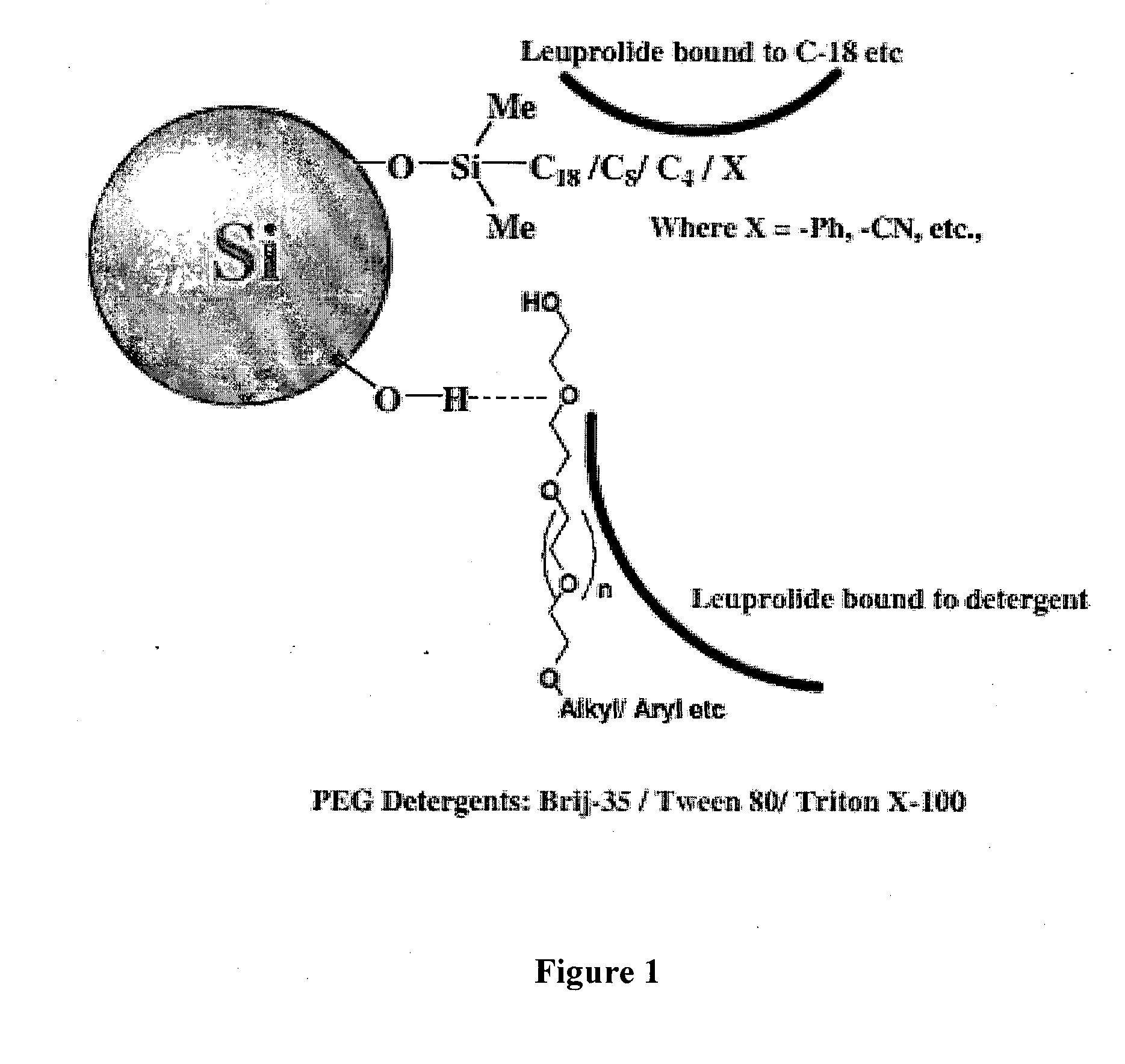Purification of organic compounds by surfactant mediated preparative HPLC
a technology of surfactant and purification process, applied in the field of purification of organic compounds, can solve the problems of limited use respect, limited affordability of methods, and high cost of large-scale hplc instruments and associated column hardware, and achieve simple, cost-effective and scalable separation process of peptides
- Summary
- Abstract
- Description
- Claims
- Application Information
AI Technical Summary
Benefits of technology
Problems solved by technology
Method used
Image
Examples
example-1
Prep-RP-HPLC of Leuprolide Acetate Using Triton X-100 as Additional Stationary Phase and Aqueous Phosphoric Acid Buffers
[0096]The C-18 reversed phase column (Reveleris C-18, 12 g, 40μ, 60 Å pore size) was saturated with Triton X-100 (12 g dissolved in 500 mL water). The excess un-bound surfactant was washed with 90% aqueous acetonitrile containing 0.1% trifluoroacetic acid to remove the un-bound surfactant. Next, the column was equilibrated with 5 column volumes (CVs) of 0.1% aqueous phosphoric acid (Buffer A). Crude Leuprolide (800 mgs, net weight by Edelhoch method) dissolved in buffer A was loaded on to the column. The column was washed with 5 CVs of Buffer A. Analytical RP-HPLC analysis of the “flow through” eluent revealed the absence of Leuprolide. When this preceding step was omitted premature elution of crude API was observed because the excess surfactant was present at a concentration that was higher than its critical micellar concentration. Next, the gradient elution proce...
example 2
Prep-RP-HPLC of Leuprolide Acetate Using Triton X-100 as Additional Stationary Phases and 0.1 mM Cetyltrimethylammonium Bromide Buffers
[0098]Reveleris® Silica derivatized C-18 column (12 g of stationary phase, 40 microns diameter particles, and 60 Angstroms pore size) was chosen and saturated with 12 g of Triton X-100 dissolved in water.
[0099]Excess un-bound surfactant was removed by washing with 90% aqueous acetonitrile containing 0.1% trifluoroacetic acid. When this step was omitted premature elution of crude API was observed because the excess surfactant was present at a concentration that was higher than its critical micellar concentration.
[0100]Next, the crude API (800 mgs of 81.7% Leuprolide, corrected weight of Leuprolide was 653.3 mgs) was loaded, and the column was washed with 5 CVs of buffer A (0.1 mM Cetyltrimethylammonium bromide and 0.1 mM sodium bicarbonate in water). Analytical RP-HPLC analysis of the “flow through” eluent revealed the absence of Leuprolide.
[0101]A li...
example 3
Prep-RP-HPLC of Leuprolide Acetate Using Tween 80 as Additional Stationary Phases and 0.1 mM Cetyltrimethylammonium Bromide Buffers
[0103]Reveleris® Silica derivatized C-18 column (12 g of stationary phase, 40 microns diameter particles, and 60 Angstroms pore size) was chosen and saturated with 12 g of Tween-80 dissolved in water.
[0104]Excess un-bound surfactant was removed by washing with 90% aqueous acetonitrile containing 0.1% trifluoroacetic acid. When this step was omitted premature elution of crude API was observed because the excess surfactant was present at a concentration that was higher than its critical micellar concentration.
[0105]Next, the crude API (800 mgs of 81.7% Leuprolide, corrected weight of Leuprolide was 653.3 mgs) was loaded, and the column was washed with 5 CVs of buffer A (0.1 mM Cetyltrimethylammonium bromide and 0.1 mM sodium bicarbonate in water). Analytical RP-HPLC analysis of the “flow through” eluent revealed the absence of Leuprolide.
[0106]A linear gra...
PUM
| Property | Measurement | Unit |
|---|---|---|
| Fraction | aaaaa | aaaaa |
| Fraction | aaaaa | aaaaa |
| Fraction | aaaaa | aaaaa |
Abstract
Description
Claims
Application Information
 Login to View More
Login to View More - R&D
- Intellectual Property
- Life Sciences
- Materials
- Tech Scout
- Unparalleled Data Quality
- Higher Quality Content
- 60% Fewer Hallucinations
Browse by: Latest US Patents, China's latest patents, Technical Efficacy Thesaurus, Application Domain, Technology Topic, Popular Technical Reports.
© 2025 PatSnap. All rights reserved.Legal|Privacy policy|Modern Slavery Act Transparency Statement|Sitemap|About US| Contact US: help@patsnap.com



